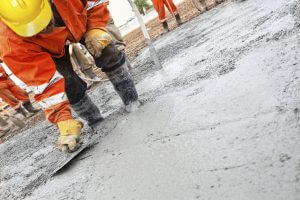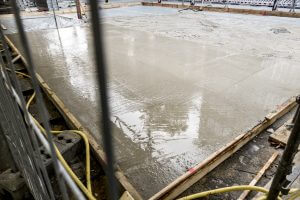Curing Concrete: How Cold Weather Affects Curing Time
Posted on 27th September 2019 by Ever Readymix Concrete
Curing concrete is an essential step in the construction process; done correctly, it ensures that the concrete you’ve laid is as strong and durable as possible.
The curing process is usually straightforward and is basically a matter of waiting for a certain amount of time to pass without letting the concrete dry out too quickly. But curing concrete in cold weather is a trickier proposition.
If you’re planning to pour ready mix concrete when the temperature is low, there are some steps you should take to ensure that the pour, and the curing process immediately afterwards goes smoothly.

How does cold weather affect concrete curing?
In cold weather, the main thing you want to avoid is letting the concrete freeze. Concrete will be severely weakened if it freezes before it can reach its full strength. The curing process takes time; concrete doesn’t gain its full strength overnight, so if ambient temperatures are below freezing the curing process can be stopped in its tracks.
There is less risk to the long term health of the concrete if temperatures remain above freezing, but you will need to be proactive and alert.

Recommended curing concrete techniques
There are a few techniques you can use to encourage and maintain the curing process even when the temperature has dropped. First things first: if you can schedule the pour when the weather is more generous — say, remaining at over 5 degrees — then do so. If you’re under-equipped to cure concrete in the cold, then don’t risk it. Reschedule and go easy on yourself; it’s not worth having to restart from scratch because your concrete wasn’t strong enough.
If you’re going ahead with the pour, then here are some things you can do to ensure your concrete beats the chill. These include:
- Leave your forms in for as long as possible — forms help to retain heat and prevent the concrete from drying out prematurely. There’s no definite time frame for this, so it is best to consult with your supplier for more specific advice.
- Check the pour site and postpone if the ground is frozen — concrete is likely to freeze if it is poured during winter onto frozen ground. The curing process will still happen, but it will be uneven, leaving a concrete slab which is only strong closer to the surface.
- Use a heated enclosure — external pour sites need some kind of enclosure to reduce the effect of low ambient temperature. The way you introduce heat — and how much heat is introduced — will need to be planned carefully. You don’t want to risk drying the concrete out. Live steam curing is recommended for enclosures, as it brings in heat and moisture, retaining the proper conditions for effective curing.
- Don’t use cold equipment — from formworks to the tools used to finish and smooth out your concrete, make sure everything that comes into contact with the mix is not too cold.
- Gradually cool after heating — once warmed to the necessary temperature, you need to avoid any abrupt or rapid cooling as this can lead to cracking or shrinkage. Instead, gradually cool the concrete and the area around it so it can acclimate to ambient temperature. You can slowly lower the temperature, bit by bit, while using insulating blankets over the surface. If forms are still in place, loosen them slowly so heat isn’t lost too quickly.

Internal curing
Internal curing is another potential technique you can use to help boost the curing process in cold weather. This method uses pre-wetted aggregates in the mix to encourage curing from within, rather than typical external methods. With internal curing, the moisture content is evenly distributed throughout the concrete, allowing it the curing process to be as efficient and consistent as possible.
Of course, even with internal curing, you will need to employ temperature control methods to prevent concrete from freezing. But internal curing can be a good method if external options are limited.
For expert concrete supply and industry knowledge, talk to Ever Readymix Concrete today. Supplying ready mix concrete throughout South Yorkshire, we can help you find the ideal concrete mix whatever the weather. From DIY builds to large scale commercial construction, our team is on hand to help with all your concrete requirements, so give us a call today.


